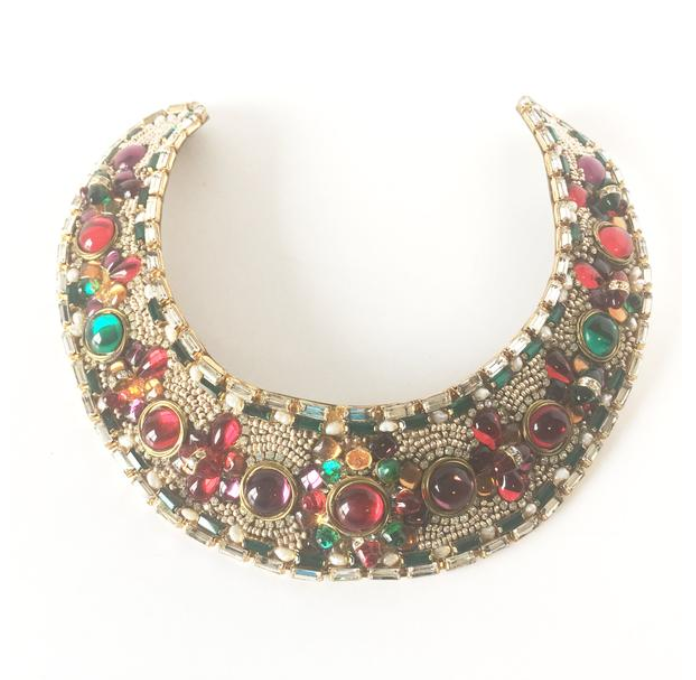
Fashion Flashback: Necklaces by Morgan Watkins
"Fashion Flashback: Necklaces" by Morgan Watkins
As more ancient jewelry is discovered and unearthed, the world learns more about how we, as a species, have lived. But while archeologist findings have paved the way to understanding past generations, some pieces, like the world’s oldest necklace, stir up more questions than they answer. Read on to learn more about the origins of the necklace and what styles reigned supreme throughout the years.
Currently holding the title as the oldest form of jewelry known to man, the first necklace dates back all the way to 130,000 BC; that’s a whopping 30,000 years before the age of modern men. The artifact was found in Croatia, and made from white-tailed eagle talons. This led to researchers raising the question: were Neanderthals more intelligent and developed than we had previously assumed? And what did jewelry mean to them?

(Image from http://www.ancientfacts.net/7-oldest-pieces-jewelry-world/)
Although these questions may be forever unanswered, we can at least draw conclusions as to why later civilizations wore ornamental neck gear. The Egyptians are famous for donning elaborate beaded collars made from glass and pottery to represent celebration and religion. Collars were also worn for funeral purposes and used to protect the wearer from evil.

(Image from www.talkingfashion.net)
Ancient Greeks sported more delicate necklaces which hung lower and were often made from gold. Animal carvings and pendants displaying cameos of landscapes dangled from the bands. In Ancient Rome, only elite members of society wore sparkling gold and silver necklaces, featuring semi-precious stones and gems like diamonds, sapphire, and amber. Ropes of pearl were introduced at this time and came in and out of style for centuries.

(Image from www.talkingfashion.net)
By the Byzantine era, the rise of religious garb took over. Christianity and Catholicism had a firm grasp on the world, inspiring individuals to represent their religion via their attire. Necklaces made of gold and silver adorned with crosses and other religious symbols were worn prominently until newer styles came into fashion around the end of the Middle Ages.

(Image from www.talkingfashion.net)
As necklines increasingly widened and lowered, necklaces became a must have accessory, at least for those who could afford them. Around the early 1600s, the choker saw its debut into the world of style. But long before they were worn as fashion statements, chokers were used on slaves as they were transported to European countries. Enslaved individuals were forced to wear brutal and uncomfortable iron chokers to keep them from escaping. With origins of cruelty, it’s hard to believe that chokers would later become symbols of patriotism. During the French Revolution, female patriots would tie thin red string around their necks to represent the Revolution and their narrow escape from death and injustice. Similarly was the red ribbon choker, which paid tribute to those who lost their lives via guillotine, while a strip of black velvet was worn when the individual was mourning the death of someone close to them.

(Image from www.talkingfashion.net)
Another popular style emerging in the 16th and 17th centuries was the locket. Common conceptions of lockets are that they contained portraits of the wearer or their loved ones, but they actually held an array of other objects too, like perfumed fabric squares and even poison. Some lockets withheld an image of the individual who gifted the necklace, while others depicted family crests, religious symbols, or allegiance to the monarchy. These special necklaces remained popular throughout the years, and they now serve as precious heirlooms for future generations.

(Image from www.talkingfashion.net)
With the Romantic period came more extravagant designs in jewelry, necklaces being no exception. Although necklaces were more popular with women than men, they were layered on generously with an army of other accessories. Gem encrusted collars, pendants adorned with jewels, pearl necklaces, ribbons and more were stacked, mixed and matched with other dazzling pieces. By the end of the 1800s, machine-made jewelry led to necklaces becoming less expensive and more accessible to everyday individuals, so everyone was in on the fashion fun.

(Image from www.talkingfashion.net)
Although the 20th century toned things down a bit, the exhilarating influence of Chanel and the Art Deco movement led to an influx of costume jewelry being worn and reimagined in the real world. Strings of pearls and glass beads, chunky collars, geometric pendants and precious gems were hot trends, up until the minimalistic age of the 90s took the wheel. Both men and women ended up opting for simple leather cords and metal chain necklaces in lieu of the bolder styles from previous decades.

(Image from www.talkingfashion.net)
These trends have withstood the test of time, as chokers, cross necklaces and delicate chains have come back into fashion both on the runway and off it. So be sure to hold your great-great-grandma’s shining golden pendant near and dear to your heart, because it could be the next necklace style revival. But if you decide lockets aren’t your thing and you’d like to pass your jewelry onto another fashion lover, be sure to get in touch with our consignment team at consign@talkingfashion.net to get the best sale value possible.

(Image from https://www.whowhatwear.com/chanel-fall-winter-2018-runway)
References:
Briggs, Helen. “Necklace Is ‘Oldest in Americas.’” BBC News 1 Apr. 2008. BBC News . Web.
“Byzantine Baubles: The History of Jewelry.” Gallery Byzantium. Gallery Byzantium, 15 Sept. 2017. Web.
“Locket History: Heart Lockets & Photo Keepsakes Through the Ages.” With You Lockets. With You Lockets, n.d. Web.
Moody, Oliver. “Neanderthal Bone Necklace ‘world’s Oldest Jewellery’.” The Times 12 Mar. 2015. Times Newspapers Limited. Web.
Parute, Edīte. “Choker Necklace - Incredible Origins And History Through The Times.” Fashionologia Historiana, 28 Aug. 2017. Web.
Torntore, Susan J. “History of Necklaces and Pendants.” lovetoknow. LoveToKnow Corp, Web.
